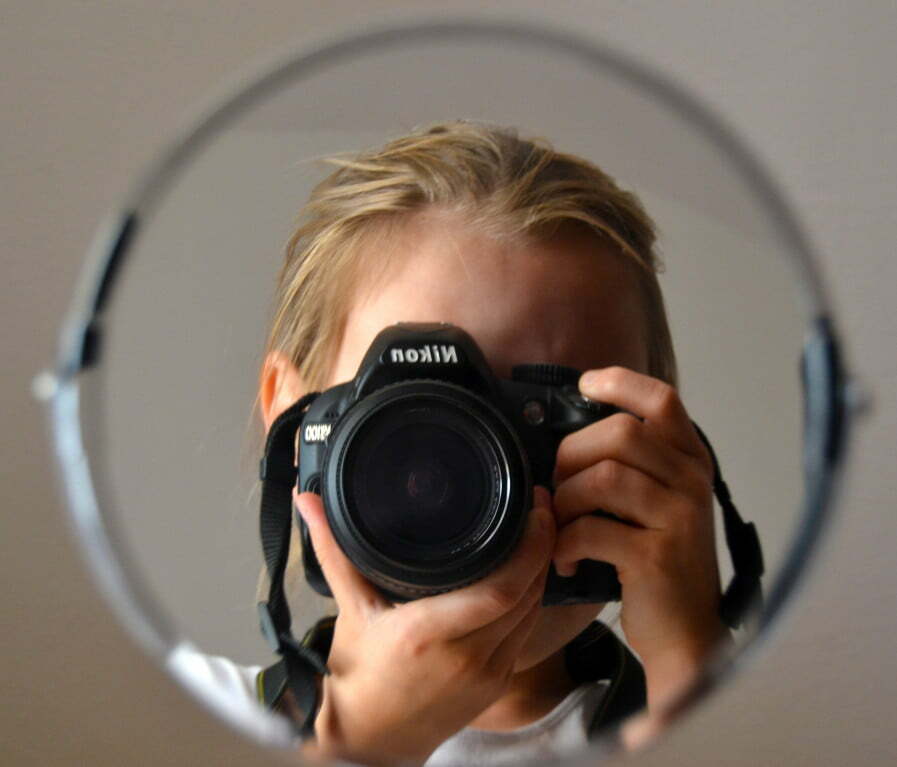If you have been shopping around for a new gadget, you may be comparing large format cameras vs digital cameras. The best digital cameras, after all, tend to fall into one category or another. Keep reading to learn more.
KEY TAKEAWAYS:
- Large format cameras use film which can allow for some unique aesthetic effects and a certain level of photographic warmth, a decent depth of field, and a suitable dynamic range.
- Digital cameras are more convenient, as images can instantly be sent to a computer or to a cloud.
- Digicams also tend to be easier to use, thanks to a range of automatic modes.
Differences Between Large Format Cameras and Digital Cameras
The most obvious difference is that large format cameras use film and digital cameras do not. Large format cameras are the go-to choice for professionals who are addicted to that “analog feel,” whereas digital cameras have the leg up when it comes to convenience. There are many other differences that are similar to when you compare a full-frame digital camera vs an APS-C camera.
Here is some more detail as to how large format and digital cameras differ.
Insider Tip
Digital cameras tend to be much smaller than large format cameras, which is something to consider.
Convenience
Large format cameras use film, meaning that film has to be developed after taking photos. This process can be costly and time-consuming, not to mention you have to actually purchase and properly install the film. Additionally, digicams typically allow all kinds of settings to be adjusted either before or after a photo is taken. As a matter of fact, many digicams let you perform slight edits on the fly right on the camera itself. For a large format camera, you would have to develop the film and scan it into a computer to use Photoshop and the like. For a digital model, you can just upload the photos to the cloud.
While some newer large format cameras do include viewscreens of some kind, so you can monitor your images as you take them, they are not typically as robust as what can be found with a digital camera. Modern digital cameras include electronic viewfinders or optical viewfinders, both of which offer a birds-eye view of the action. This allows you to know exactly what you are taking a photo of before you take it and allows you to check the photo out after it has been taken.
Ease-of-Use
Digicams include all kinds of automatic modes for shutter functionality, exposure, autofocus, and more. This makes them perfect for amateur photographers and all-around enthusiasts. Large format cameras, on the other hand, typically lack automatic modes, as they are fully analog by design. Digicams also offer manual modes, but you’ll be able to choose between manual modes and digital modes.
F.A.Q.S
What are the cons of medium format cameras?
Medium format digital cameras are usually larger and bulkier than standard DSLR cameras. Medium format cameras do integrate with a nifty format lens or two, though the number of lenses available will be fewer than with a full-frame DSLR. As for image quality, format photography, medium format sensors, and format lenses are all up to snuff.
What is camera format? What does camera format mean?
The term camera format refers to the size of the image sensor. Medium format cameras, for instance, feature a medium-sized image sensor that may offer a shallower depth than a large digital sensor.
Can you use an FX lens on a DX camera body?
Yes. These types of lenses should be interchangeable.
STAT: “The main advantage of large format film is a higher resolution at the same pixel pitch or the same resolution with larger pixels or grains which allows each pixel to capture more light enabling exceptional low-light capture.” (source)



































![Best Point and Shoot Camera in [year] ([month] Reviews) 27 Best Point and Shoot Camera in 2026 (January Reviews)](https://www.gadgetreview.dev/wp-content/uploads/Nikon-Coolpix-B500.jpg)
![Best Underwater Camera in [year] ([month] Reviews) 28 Best Underwater Camera in 2026 (January Reviews)](https://www.gadgetreview.dev/wp-content/uploads/best-underwater-camera-image.jpg)
![Best Digital Cameras in [year] ([month] Reviews) 29 Best Digital Cameras in 2026 (January Reviews)](https://www.gadgetreview.dev/wp-content/uploads/what-is-resolution-on-digital-camera-1.jpg)
![Best Digital Camera Docking Stations in [year] 30 Best Digital Camera Docking Stations in 2026](https://www.gadgetreview.dev/wp-content/uploads/best-digital-camera-docking-stations-image.jpg)
![Best Vlogging Camera in [year] ([month] Reviews) 31 Best Vlogging Camera in 2026 (January Reviews)](https://www.gadgetreview.dev/wp-content/uploads/best-vlogging-camera-image.jpg)
![Best Mirrorless Camera in [year] ([month] Reviews) 32 Best Mirrorless Camera in 2026 (January Reviews)](https://www.gadgetreview.dev/wp-content/uploads/best-mirrorless-camera-image.jpg)
![Best GoPro in [year] ([month] Reviews) 33 Best GoPro in 2026 (January Reviews)](https://www.gadgetreview.dev/wp-content/uploads/best-gopro-image.jpg)
![Best Digital Camera Tripods in [year] 34 Best Digital Camera Tripods in 2026](https://www.gadgetreview.dev/wp-content/uploads/best-digital-camera-tripods-image.jpg)
![Best Canon Digital Cameras in [year] 35 Best Canon Digital Cameras in 2026](https://www.gadgetreview.dev/wp-content/uploads/best-canon-digital-cameras-image.jpg)
![Best Polaroid Digital Cameras in [year] 36 Best Polaroid Digital Cameras in 2026](https://www.gadgetreview.dev/wp-content/uploads/best-polaroid-digital-cameras-image.jpg)
![Best Small Digital Camera Cases in [year] 37 Best Small Digital Camera Cases in 2026](https://www.gadgetreview.dev/wp-content/uploads/best-small-digital-camera-case-image.jpg)
![Best Digital Camera USB Cables in [year] 38 Best Digital Camera USB Cables in 2026](https://www.gadgetreview.dev/wp-content/uploads/best-digital-camera-usb-cable-image.jpg)
![Best Digital Camera Bags in [year] 39 Best Digital Camera Bags in 2026](https://www.gadgetreview.dev/wp-content/uploads/best-digital-camera-bag-image.jpg)
![Best Sony Digital Cameras in [year] 40 Best Sony Digital Cameras in 2026](https://www.gadgetreview.dev/wp-content/uploads/best-sony-digital-cameras-image.jpg)
![Best Panasonic Digital Cameras in [year] 41 Best Panasonic Digital Cameras in 2026](https://www.gadgetreview.dev/wp-content/uploads/best-panasonic-digital-cameras-image.jpg)
![Best Digital Camera Accessories in [year] 42 Best Digital Camera Accessories in 2026](https://www.gadgetreview.dev/wp-content/uploads/best-digital-camera-accessories-image.jpg)
![Best Kodak Digital Cameras in [year] 43 Best Kodak Digital Cameras in 2026](https://www.gadgetreview.dev/wp-content/uploads/best-kodak-digital-cameras-images.jpg)
![Best Video Cameras in [year] ([month] Reviews) 44 Best Video Cameras in 2026 (January Reviews)](https://www.gadgetreview.dev/wp-content/uploads/best-video-cameras-image.jpg)
![Best Compact Cameras in [year] 45 Best Compact Cameras in 2026](https://www.gadgetreview.dev/wp-content/uploads/best-compact-camera-image.jpg)
![Best Digital Cameras with Wifi in [year] 46 Best Digital Cameras with Wifi in 2026](https://www.gadgetreview.dev/wp-content/uploads/best-digital-camera-with-wifi-image.jpg)



















